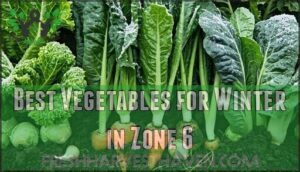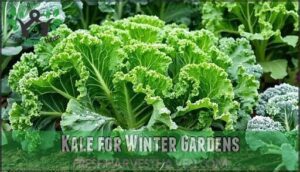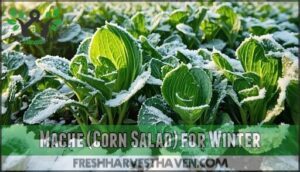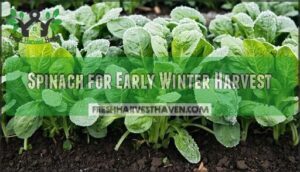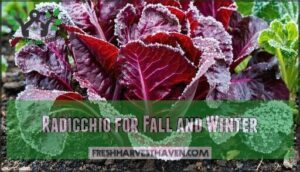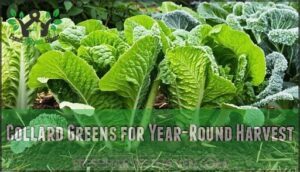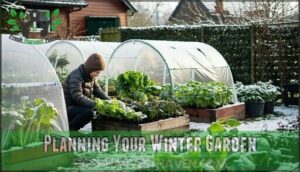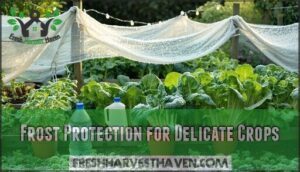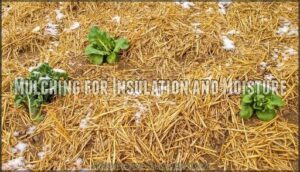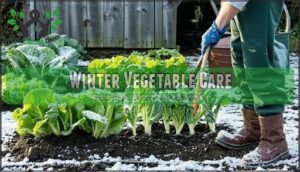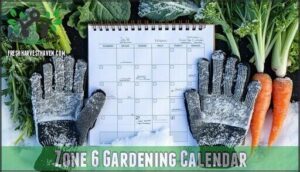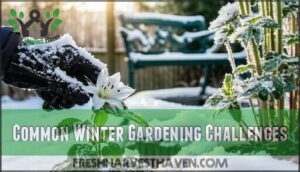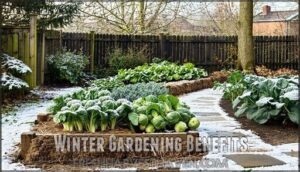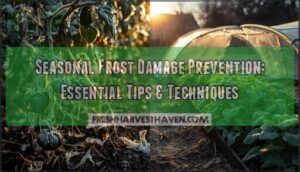This site is supported by our readers. We may earn a commission, at no cost to you, if you purchase through links.
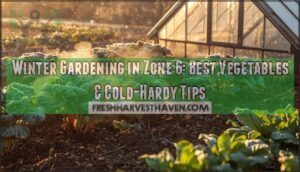 Winter gardening in zone 6 opens up a world of fresh possibilities when most gardens lie dormant.
Winter gardening in zone 6 opens up a world of fresh possibilities when most gardens lie dormant.
You can successfully grow cold-hardy vegetables like kale, spinach, mache, and collard greens through winter’s chill. The secret? Start planting in late summer and early fall, giving crops time to establish before harsh weather hits.
Your zone 6 garden can handle temperatures down to -10°F, but you’ll need protection methods like row covers and cold frames for tender varieties. Smart timing beats brute force every time—plant too late and you’re fighting an uphill battle.
With proper planning and the right varieties, your winter harvest can rival any summer bounty. This approach allows for a successful winter garden, making winter gardening a viable option.
Table Of Contents
- Key Takeaways
- Winter Gardening in Zone 6
- Best Vegetables for Winter in Zone 6
- Choosing Cold-Hardy Crops
- Planning Your Winter Garden
- Winter Gardening Techniques
- Winter Vegetable Care
- Zone 6 Gardening Calendar
- Common Winter Gardening Challenges
- Winter Gardening Benefits
- Winter Gardening Success Tips
- Frequently Asked Questions (FAQs)
- What to grow in winter zone 6?
- When should I start my winter garden?
- When to start winter sowing in zone 6a?
- What plants are cold hardy in Zone 6?
- When to start winter sowing in zone 6?
- What vegetables grow in winter zone 6?
- What plants can you winter sow in Zone 6?
- When to plant winter crops zone 6?
- What is the best winter cover crop for zone 6a?
- What to do in the garden in January zone 6?
- Conclusion
Key Takeaways
- Start seeds and plant cold-hardy crops like kale, spinach, and mache in late summer to give them time to establish before winter’s chill sets in.
- Use row covers, cold frames, and plenty of mulch to protect your veggies and create microclimates that help them survive zone 6’s deep freezes.
- Water and fertilize with care, adjusting routines for cold weather—only water when soil’s above 40°F and use slow-release, low-nitrogen fertilizers.
- Stagger plantings and track frost dates so you get continuous harvests and maximize your garden’s winter yield.
Winter Gardening in Zone 6
Zone 6 winter gardening transforms your backyard into a four-season food source. You’ll face temperatures dropping to -10°F, but that’s where microclimate creation becomes your secret weapon.
Winter’s harsh bite becomes your garden’s greatest teacher—embrace the cold and watch your skills grow.
Position cold frames and row covers in south-facing spots to capture maximum sunlight and create warmer pockets for your crops. Don’t overlook snow blanket benefits—that white layer actually insulates your plants like nature’s compost.
Speaking of winter composting, keep adding kitchen scraps to maintain soil health through the cold months. Start seed saving from your hardiest performers, and welcome garden wildlife like birds that’ll help control pests.
With proper planning, your winter vegetable garden becomes a productive sanctuary that laughs in winter’s face, utilizing winter gardening techniques to thrive.
Best Vegetables for Winter in Zone 6
Your winter vegetable garden can thrive with the right hardy vegetables zone 6 offers.
These best winter vegetables handle freezing temperatures while providing excellent nutritional value and culinary uses.
Top performers include:
- Leafy greens like kale and spinach with superior hardiness ratings, becoming sweeter after frost
- Root vegetables such as carrots and turnips that store energy underground through winter
- Brassicas including Brussels sprouts and cabbage for steady cold-weather growth
- Alliums like garlic greens and scallions offering robust winter durability
These zone 6 winter gardening champions also support companion planting strategies and seed saving opportunities for next season’s success.
For continuous harvests, consider succession planting methods.
Choosing Cold-Hardy Crops
Selecting the right cold-hardy crops makes the difference between a thriving winter garden and one that barely survives the season.
You’ll want to focus on vegetables that both tolerate Zone 6’s harsh conditions and actually improve in flavor after experiencing frost.
Kale for Winter Gardens
Think of kale as your winter garden’s MVP—unfazed by icy mornings and boasting superstar winter hardiness.
Curly, Lacinato, or Dwarf Siberian, these kale varieties don’t just survive; they thrive in zone 6.
Plant in late summer for deep roots, then shield young leaves with mulch or row covers to boost pest resistance.
You’ll love harvesting outer leaves as needed, turning nutrient-rich kale into chips, soups, or stir-fries.
With strong nutritional value and kitchen versatility, kale stands out among hardy vegetables zone 6, making it a smart pick for winter vegetables and cold-weather cooking ideas.
For zone 6B, starting seeds indoors around March 1st allows for early planting success.
Mache (Corn Salad) for Winter
One exceptional mache variety transforms your zone 6 winter garden into a nutritional powerhouse, surviving temperatures down to 5°F while delivering sweet, nutty flavors.
Here’s how to master mache cultivation:
- Select hardy mache varieties like ‘Vit’ or ‘Baron’ for maximum cold tolerance
- Direct sow seeds in late August through early September for winter harvests
- Provide light protection using row covers during extreme cold snaps
- Harvest outer leaves continuously, allowing plants to keep producing
- Pair with mild greens in salads to showcase mache’s distinctive taste
Mache thrives best with full sun exposure.
Spinach for Early Winter Harvest
Growing spinach varieties like ‘Bloomsdale’ and ‘Winter Bloomsdale’ transforms your winter garden zone 6 into a leafy paradise. These winter vegetables handle frost down to 15°F, making winter gardening surprisingly manageable.
The specific cold tolerance of each variety is as follows:
| Variety | Cold Tolerance |
|---|---|
| Bloomsdale | 15°F |
| Winter Bloomsdale | 10°F |
| Space | 4-6 inches |
To plant, seeds should be sown ½ inch deep in nutrient-rich soil 2-3 weeks before frost. Light freezes actually sweeten the leaves—nature’s flavor enhancement system at work!
For ongoing care, keep soil moist and harvest outer leaves continuously for fresh spinach all season. To extend the harvest, consider using row covers for protection to protect your crop, ensuring a continuous harvest of fresh spinach.
Radicchio for Fall and Winter
Beyond typical lettuce varieties, radicchio brings stunning red and purple hues to your zone 6 winter garden. This chicory relative thrives in cool temperatures and develops sweeter flavors after frost sweetens its naturally bitter leaves.
Radicchio varieties like ‘Rosso di Treviso’ and ‘Fiero’ tolerate frosts down to 20°F:
- Planting radicchio works best from mid-August to early September for winter harvests
- Harvesting radicchio continues from November through February with proper protection
- Radicchio nutrition surpasses regular lettuce in vitamins and antioxidants
You’ll find radicchio recipes perfect for braising or adding crunch to winter salads.
These cold weather crops prove that winter vegetables can deliver both flavor and color to your winter garden crops.
Collard Greens for Year-Round Harvest
While radicchio adds vibrant color, collard greens deliver reliable harvests throughout zone 6’s harsh winters. These winter garden crops laugh at freezing temperatures and keep producing when other vegetables surrender.
Master collard greens with these proven strategies:
- Select collard varieties like ‘Georgia Southern’ for superior pest resistance and cold tolerance.
- Space plants 18-24 inches apart to meet their nutrient needs and airflow requirements.
- Practice companion planting with onions and herbs to naturally deter pests.
- Apply 3-inch mulch layers for root protection during cold weather crops season.
- Learn proper cooking methods—harvest outer leaves while centers continue growing for winter gardening success.
Planning Your Winter Garden
Planning your winter garden in zone 6 requires careful consideration of timing, soil preparation, and garden placement to maximize your harvest potential.
With proper scheduling and strategic layout choices, you’ll set yourself up for fresh vegetables throughout the coldest months, ensuring a successful harvest due to proper planning.
Planting Schedules for Zone 6
Success in winter gardening hinges on Frost Date Timing – your roadmap to fresh vegetables when others give up. Since Zone 6’s average first frost hits around late October, you’ll need to work backwards from this pivotal date.
Seed Starting Indoors becomes your secret weapon for extending the season. Begin 10-12 weeks before first frost (mid-August) for crops like kale and spinach. This head start protects seedlings from summer’s brutal heat while maximizing your garden space.
Your Direct Sow Timing varies by crop type:
- Root vegetables like carrots and turnips: 12-14 weeks before frost (late July to early August)
- Garlic Planting: 4-6 weeks before frost (September to early October)
- Radishes and mache: Every 2 weeks until hard freeze
Local Adjustments matter since Zone 6a differs from 6b by about a week. Create a personalized planting schedule using your area’s specific frost dates – this simple step transforms winter garden planning from guesswork into guaranteed success.
Preparing The Soil for Winter
To get your zone 6 winter garden off on the right foot, begin with soil testing—even if, at first, you don’t think you need it.
Check your pH and nutrient balance so you know exactly what you’re up against. From there, add soil amendments like compost or worm castings for a healthy dose of organic matter—think of this as your garden’s winter vitamin.
Good soil preparation improves drainage, especially essential in cold, wet winters. If drainage improvement is needed, try raised beds.
Next, lay down two inches of mulch; straw, shredded leaves, or bark work for different mulch types, insulating roots and locking in moisture.
Garden Layout for Maximum Sunlight
Winter’s short days mean every ray counts when planning your garden layout for maximum sunlight exposure. Your garden’s success hinges on smart positioning that captures precious winter warmth.
Sunlight angles shift dramatically in winter, requiring strategic layout optimization. Position rows east-to-west so plants catch the sun’s arc throughout the day. This simple trick maximizes light exposure for your winter gardening in zone 6 setup.
Here’s your garden planning blueprint:
- Place tall crops like Brussels sprouts on the north side to prevent shading
- Use reflective surfaces like aluminum mulch to bounce light onto plants
- Install windbreaks along exposed edges for microclimate creation
- Group similar-height plants together for even sun protection
This thoughtful approach transforms your winter garden sunlight from scarce to sufficient, helping cold-hardy vegetables thrive despite harsh conditions.
Winter Gardening Techniques
Success with winter gardening in Zone 6 depends on mastering three key protection techniques that shield your crops from harsh conditions.
These methods work together to create microclimates that keep your vegetables thriving when temperatures drop well below freezing, utilizing techniques that are essential for winter gardening.
Frost Protection for Delicate Crops
When temps drop in zone 6, your delicate crops need smart frost protection strategies.
Material Selection matters—lightweight blankets or frost cloth work better than heavy tarps that crush plants.
Create Microclimate Creation by grouping containers or using water-filled jugs that release heat overnight.
Emergency Measures like overturned buckets save desperate situations.
Ventilation Needs prevent mold under covers, while Supplemental Heating from string lights adds extra plant protection for your winter harvest zone 6 garden.
Using Row Covers and Cold Frames
Beyond basic frost protection, row covers and cold frame gardening transform your zone 6 winter garden into a productive oasis.
These DIY cold frames and insulating covers create microclimates that keep vegetables thriving when temperatures drop.
Smart gardeners rely on these five proven techniques:
- Select appropriate row cover material based on expected temperatures and crop needs
- Build ventilation strategies into cold frames using automatic openers or manual lifting
- Layer lightweight covers over heavier ones for adjustable protection levels
- Position structures to maximize morning sun exposure while blocking harsh winds
- Monitor daily temperatures inside covers to prevent overheating damage.
Row covers offer portable protection you can move as needed, while cold frames provide permanent shelter for extending harvest periods.
You can find various cover materials for different needs.
Both methods require proper airflow management to prevent moisture buildup and plant diseases during winter gardening seasons.
Mulching for Insulation and Moisture
Once you’ve set up your row covers and cold frames, it’s time to turn your attention to mulching—a real game-changer for winter gardening in zone 6.
A well-chosen mulch acts like a thick quilt for your plants, locking in warmth, maintaining Moisture Retention, and minimizing wild temperature swings.
Aim for a Mulch Depth of 3–4 inches, choosing Material Choices like straw, shredded leaves, or wood chips for high-quality plant insulation and soil preparation.
Consider garden mulch options for zone 6 to protect your plants.
Add your mulch after the first hard frost to lock in warmth without rolling out the welcome mat for pests.
Keep mulch away from plant stems for airflow and Pest Control.
This practice smooths out freeze-thaw cycles, keeping roots snug and spring growth strong.
Winter Vegetable Care
Caring for your winter vegetables requires adjustments to your regular gardening routine since cold weather changes how plants absorb water and nutrients.
You’ll need to modify your watering schedule, fertilizing approach, and pest management strategies to keep your crops healthy through Zone 6’s harsh winter months, which involves understanding how to care for your vegetables during this harsh time.
Watering and Fertilizing in Winter
Cold-hardy vegetables need careful Winter Hydration and Dormancy Feeding to thrive through harsh zone 6 conditions.
Your winter garden maintenance becomes simpler when you understand how Soil Temperature affects Nutrient Absorption.
Winter watering requires timing and technique adjustments.
Follow these essential guidelines:
- Water only when Soil Temperature stays above 40°F during midday warmth
- Check soil moisture weekly by testing depth with your finger – don’t guess
- Apply water at soil level to prevent ice formation on plant foliage
- Use deep, infrequent sessions rather than light, frequent applications
Fertilizer Types matter during dormancy.
Apply slow-release, low-nitrogen options monthly to support root development without encouraging tender growth that frost damages.
Your plant care strategy should focus on maintaining steady Nutrient Absorption rates while avoiding overfeeding that weakens cold tolerance in your winter gardening efforts.
Pruning and Training for Better Growth
Proper watering sets the stage, but pruning techniques and training methods keep your zone 6 winter garden thriving through harsh conditions. Growth optimization requires strategic cuts and smart plant support systems that work with nature’s rhythms.
Winter pruning isn’t about dormancy—it’s about directing energy where it counts most. Your coldhardy plants need focused attention to maximize their potential during shortened daylight hours.
Essential winter gardening maintenance includes:
- Remove yellowing leaves weekly to prevent disease spread and redirect plant energy
- Install sturdy supports for climbing varieties before winter winds topple them over
- Pinch flower buds on leafy greens to encourage continued foliage production
Smart tool selection makes these tasks manageable even in cold weather, ensuring your training methods support season-long harvests.
Pest and Disease Management in Winter
Why does winter pest management matter when your garden looks half-asleep? Cold temperatures eliminate 70-90% of soft-bodied pests like aphids and thrips, but winter garden pests still pose real threats.
Disease prevention starts with proper sanitation—removing dead plant material that harbors harmful organisms reduces overwintering pest populations substantially. Local exterminators can provide termite control programs to help protect your home.
Regular winter monitoring during mild spells prevents small infestations from becoming major problems. Root maggots and cabbage worms often survive under crop debris, making weekly inspections essential for identifying winter pests early.
Common Winter Threats Organic Solutions
Plant hardiness extends beyond cold tolerance—it includes resistance to winter garden diseases like gray mold and downy mildew. Proper ventilation cuts fungal disease pressure by 60% compared to unventilated spaces.
Avoid overwatering when soil temperatures drop below 40°F to prevent root rot. Winter gardening success depends on balancing protection with air circulation for healthy plants.
Zone 6 Gardening Calendar
Timing is everything in the context of winter gardening success in zone 6.
You’ll need a clear calendar that maps out planting dates, harvest windows, and maintenance tasks to keep your cold-weather crops thriving through the harsh months ahead.
Planting Dates for Winter Vegetables
Success hinges on mastering your planting timeline for zone 6 winter vegetables. Your frost dates serve as the backbone of your entire planting schedule, with November 1st marking the typical first frost in most zone 6 areas.
Your frost dates are your garden’s heartbeat—listen closely and time everything around them.
Indoor sowing gives you control over germination conditions, while direct sowing works best for root crops that dislike transplanting. Start planning your winter garden using these key milestones:
- Mid-July to early August: Begin seed starting for cold-hardy crops like kale and spinach indoors
- Late July to early August: Direct sow root vegetables including carrots, radishes, and turnips
- September to early October: Plant garlic cloves for next year’s harvest
- Late October: Install row covers and cold frames before temperatures drop
Count backward from your desired harvest date, factoring in each variety’s days to maturity for perfect timing.
Harvest Times for Winter Crops
Mastering perfect timing for your winter harvest transforms ordinary vegetables into extraordinary meals.
Understanding frost effects and storage methods helps you maximize both flavor and shelf life throughout the cold months.
Zone 6 gardeners face unique challenges with extending harvest periods, but proper timing yields incredible rewards.
Peak flavors develop when you align your winter harvest schedule with natural temperature fluctuations.
- Leafy greens like kale and spinach develop sweeter flavors after frost exposure – harvest continuously as needed
- Root vegetables including carrots and beets require harvesting before ground freezes completely solid
- Brussels sprouts and collards actually taste better after experiencing light frosts
- Winter squash needs collection before hard freezes to guarantee proper long-term storage
Your winter gardening success depends on watching weather forecasts closely.
Staggered harvests let you enjoy fresh winter vegetables throughout the entire season while optimizing storage potential for maximum food security.
Seasonal Garden Maintenance Tasks
Once you’ve got harvest times marked on your calendar, it’s time to shift your focus to winter garden maintenance.
Staying on top of winter gardening in Zone 6 means checking things off your garden maintenance list—even when there’s frost on your boots.
Here are a few tasks you can’t afford to skip:
- Inspect cold frames, hoop houses, and row covers for snow damage as part of your regular structure checks.
- Keep your tools sharp and rust-free to make plant monitoring and pruning easier.
- Add or refresh mulch for extra insulation and to lock in much-needed moisture around roots.
- Watch soil moisture levels; you want roots hydrated, not waterlogged.
These winter garden care steps keep soil health strong and your garden ready for spring.
Common Winter Gardening Challenges
You’ll face some unique hurdles when tending a winter garden in zone 6, from stubborn cold snaps to surprise pests that just won’t leave.
Knowing how to tackle these challenges will keep your plants thriving, even when the weather feels determined to test your patience.
Dealing With Extreme Cold Snaps
Your planting calendar sets the stage, but when the weather forecast screams "polar vortex," you need a game plan. Emergency Protection means acting fast – don’t wait until you’re scraping ice off your car windshield.
Stack multiple layers of frost protection like you’re bundling up for a blizzard. Throw heavy blankets over cold frames, pile extra mulch around root crops, and consider Supplemental Heating with water jugs or compost heat. Wind Protection matters too – even a simple tarp can block those bone-chilling gusts.
Snow Cover actually helps insulate plants, so don’t brush it off unless it’s crushing them. After extreme cold passes, patience pays off. Thawing Frozen soil takes time, and your zone 6 plants might look beaten up but often bounce back. Remove protection gradually – sudden temperature swings can shock plants worse than the cold itself.
Managing Moisture in Winter
Extreme cold isn’t your only winter gardening headache in zone 6—moisture management deserves a spot on your checklist, too.
Stick your finger two inches into the soil to judge if it’s watering time. Snow provides surprising insulation, but don’t let it fool you; waterlogged roots lead straight to regret.
Use these strategies in your winter garden management:
- Avoid overwatering—timing matters just as much in winter.
- Keep condensation control sharp inside hoop houses.
- Examine drainage solutions around each plant for Preventing Rot.
- Leverage snow impact, but don’t skip regular winter garden watering.
Balance is everything, and following these tips will help you achieve it in your winter garden, ensuring that you can effectively manage the challenges that come with the season.
Preventing Pests and Diseases in Winter
Winter pest control doesn’t mean you’re pest-free. Cold weather slows bugs down but doesn’t eliminate them.
Smart disease prevention tips and organic solutions keep your zone 6 winter garden healthy.
Your pest management strategy includes:
- Remove all plant debris harboring overwintering insects and disease spores
- Confirm proper ventilation importance around cold frames and protective structures
- Practice moisture control preventing fungal issues in damp conditions
- Apply beneficial nematodes before ground freezes solid
Regular plant health monitoring catches problems early.
Winter Gardening Benefits
Winter gardening in Zone 6 offers you remarkable advantages that extend far beyond simply having fresh vegetables during the colder months.
You’ll discover that maintaining a winter garden helps extend your growing season, increases the variety of crops you can grow throughout the year, and actually improves your soil’s health for better spring planting, which is a significant advantage.
Extending The Growing Season
It’s no secret that season extension methods, like a simple cold frame or row cover, can turn your zone 6 garden into a four-season operation.
Indoor growing and microclimate creation let you outsmart winter, keeping greens on your table longer.
With practical succession planting or crop rotation, winter gardening feels less like a chore, more like extending growing season magic year-round.
Increasing Crop Diversity
Beyond traditional kale and spinach, diversifying your zone 6 winter garden with unusual varieties creates a robust food system that thrives despite harsh conditions.
When you plant uncommon cold-tolerant plants like mache, radicchio, and Asian greens alongside familiar winter vegetables, you’re basically building insurance against crop failure.
Smart crop diversity transforms your winter gardening approach through these key strategies:
- Succession planting – Sow seeds every 2-3 weeks to stagger harvests and extend your growing season
- Companion planting – Pair beneficial plants like carrots with onions to boost growth and deter pests naturally
- Vertical gardening – Use trellises and towers to maximize space while growing more varieties
Mix leafy greens with root vegetables and herbs for balanced nutrition.
Crop rotation between seasons prevents soil depletion and pest buildup, keeping your winter vegetables healthy year after year.
Improving Soil Health
Winter’s freeze-thaw cycles naturally improve your soil structure by breaking up compacted earth.
Smart soil preparation means adding compost and organic matter now, giving them months to decompose before spring planting.
Winter mulching protects beneficial microorganisms while slowly releasing nutrients into the soil.
Cover cropping with winter rye prevents erosion and adds nitrogen through natural processes.
This soil amendments approach transforms winter downtime into active compost application season, creating richer ground for next year’s harvest through improved drainage improvement and enhanced winter garden soil health.
Balanced pH is essential, so consider adjusting soil composition for ideal growth.
Winter Gardening Success Tips
Winter gardening success starts with proper timing and the right plant choices for your zone 6 conditions.
You’ll get the best results by planning ahead, selecting proven cold-hardy varieties, and learning from each season’s challenges and victories.
Starting Early for Best Results
Starting early gives your winter garden the best shot at success. Your frost dates drive everything, so mark your calendar 10-12 weeks before that first freeze hits your area.
Here’s your game plan for zone 6 winter gardening:
- Mid-July seed starting gets transplants ready for late summer planting
- Soil preparation with compost happens while ground’s still workable
- Indoor sowing protects seedlings from summer heat stress
- Transplant timing when plants hit 6 inches tall
This planting schedule lets you beat the clock. Late summer planting means your crops establish strong roots before winter’s grip tightens.
Choosing The Right Varieties
Your variety selection makes or breaks winter success in zone 6. Look beyond pretty pictures on seed packets—Hardiness Ratings tell the real story. Disease Resistance prevents problems when harsh weather limits your intervention options.
Winning Traits Why They Matter
Disease Resistance
Compact Growth Habits
Fast Maturity
Cold-tolerant plants like ‘Winterbor’ kale adapt to your USDA hardiness zone through Local Adaptation. Their compact Growth Habits fit under protection, while Flavor Profiles actually improve after frost hits these winter vegetables.
Learning From Experience
Nobody masters winter gardening in zone 6 without learning from both victories and defeats. Each frozen leaf and surviving plant teaches valuable lessons that transform future seasons.
Every frost-bitten leaf tells a story—listen carefully, and winter will teach you to garden better.
Keep detailed records of what works and what doesn’t. Track planting dates, protection methods, and harvest outcomes. These notes become your personal guide for winter gardening success. Mistakes to Avoid turn into valuable data when you document which varieties failed and why. Experimentation Benefits multiply when you note unexpected successes, like discovering which kale survived without protection.
Learning from experience requires:
- Recording everything: Document planting dates, weather events, and crop performance
- Analyzing failures: Study why certain plants didn’t survive to improve next season
- Adapting methods: Adjust timing and protection strategies based on your observations
Continuous Learning happens naturally when you embrace each season as classroom time. Local Wisdom develops through hands-on experience with your specific microclimate. Adaptive Strategies emerge from systematic observation, helping you overcome winter gardening challenges with proven winter gardening lessons.
Frequently Asked Questions (FAQs)
What to grow in winter zone 6?
Your winter garden can bloom like a snow-kissed oasis! You’ll thrive growing hardy kale, spinach, mache, carrots, turnips, radishes, Brussels sprouts, and collard greens with proper protection.
When should I start my winter garden?
You’ll want to sow seeds about 8–10 weeks before your area’s first frost, so mark your calendar for late July or early August.
Trust me, your plants will thank you for the head start when cold hits.
When to start winter sowing in zone 6a?
Start winter sowing outdoors in late February through March when you can work the soil. You’ll directly sow cold-hardy seeds that need cold stratification to germinate properly in spring.
What plants are cold hardy in Zone 6?
Cold-hardy plants thrive despite freezing temps, but which ones actually survive zone 6’s brutal winters?
You’ll find success with kale, spinach, mache, Brussels sprouts, carrots, and radishes—they’re your winter garden champions.
When to start winter sowing in zone 6?
You’ll get best results planting semi-hardy seeds ten weeks before first frost and hardy varieties eight weeks prior. This timing gives seedlings enough growing time before winter hits.
What vegetables grow in winter zone 6?
You can grow kale, spinach, mache, collard greens, carrots, radishes, turnips, Brussels sprouts, and Swiss chard.
These hardy vegetables thrive in cold weather and actually taste sweeter after frost hits your garden.
What plants can you winter sow in Zone 6?
Patience plants the seeds of tomorrow’s harvest – you can winter sow spinach, kale, lettuce, arugula, radishes, and peas in Zone 6 for early spring growth.
When to plant winter crops zone 6?
Kick off winter crop planting in Zone 6 by starting seeds indoors in August, and direct-sow hardy veggies outdoors by late July.
Aim to transplant seedlings when they’re 6 inches tall, and watch fall’s chill for timing.
What is the best winter cover crop for zone 6a?
Like a protective blanket shielding the earth, winter rye stands as your best cover crop for zone 6a.
It thrives in cold temperatures, prevents erosion, and improves soil structure when you till it under come spring.
What to do in the garden in January zone 6?
Check on plants under row covers and cold frames, ensuring proper ventilation on sunny days. Remove snow buildup, monitor soil moisture, and plan your spring garden layout.
Conclusion
Picture Pat, a zone 6 gardener who harvested crisp spinach on New Year’s Day—proof that winter gardening in zone 6 isn’t just possible, it’s rewarding.
If you start early and pick the right cold-hardy crops, you’ll enjoy fresh greens even after the first snowfall.
Remember, timing and protection matter more than brute force.
With the right planning, your winter harvest can rival summer’s bounty.
Try new varieties and embrace the quiet productivity of a winter garden.


